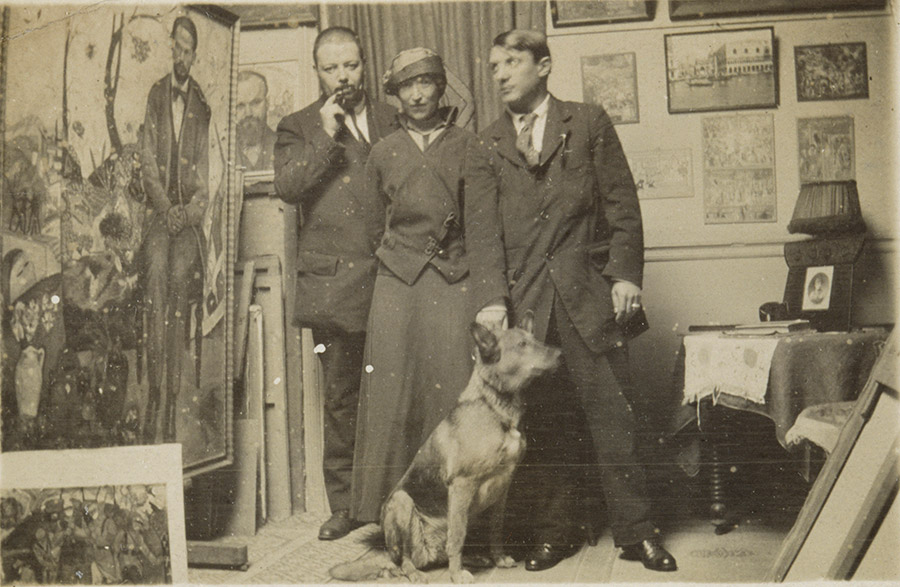Clues in Alexander Zinoviev's notebooks
In July 1914, Diego Rivera suggested to Zinoviev that he join him in the Balearic Islands, but he refused and enlisted in the army for the rest of the war. Was it a way of showing his attachment to France? Was it to move away from his role as a secret agent, which he had accepted under pressure, or, on the contrary, did he do it so as to report back to Russia on what was happening on the front line, and keep an eye on the many other Russians who were there as well? We do not know.
The well-documented Wikipedia entry[1] tells us that “he joined the Foreign Legion and did his training in Battalion C of the 2nd Foreign Regiment, stationed at the Mailly camp between the Marne and the Aube. On 18 October, 1914, the unit left for the Craonnelle trenches, in the Aisne valley. There he fought on the front line, primarily as a machine gunner.”
Zinoviev chose to give his own account of the war in his journals, photographs, and numerous drawings. The entire content of his journals is available on a Russian website.[2] They cover the period from December 25, 1914 –Christmas Day– to November 15, 1918, when the armistice found him in New York. He happened to be finishing an exhausting journey through the United States and Canada with close to one hundred legionnaires to raise funds in support of France. As part of the tour, they were received at the White House by President Woodrow Wilson. Alexandre Zinoviev spent the rest of his life in France, where he designed set and costumes for music hall shows and clothing for the fashion industry. Having received French citizenship in 1938, he died in Paris in 1977.
His notebooks allow us to follow, almost on a daily basis, his assignments, the battles fought and the morale of the troops, with interruptions, particularly when he was not posted. Therefore, we can reconstruct when he may have been back in his studio in Paris, which he mentions from time to time. During the period of interest to us, he could have been in his studio between July 13, 1915 and June 1, 1916, and then between early September 1916 and February 20, 1917.[3]These various elements lead to the conclusion that the photograph could have been taken in one of two periods, the first from mid-July 1915 to early 1916. If that were the case, Rivera and Picasso would have had to be reconciled, which is not inconceivable. Rivera could only have been flattered that Picasso borrowed an idea from him, if that had in fact been the case. John Richardson went so far as to say that it was the only original idea Rivera brought to Cubism! [4] Picasso, on the other hand, did not have much to fear from this competitor—after all, a follower who was venturing into Cubism at a time when he himself was moving away from it. Proof of this are the “Ingresque” drawings Rivera produced from 1917 on, whereas Picasso had made his first piece in that style—a portrait of Max Jacob which Rivera had undoubtedly seen—in January 1915.
Angelina Beloff gave birth to their son Dieguito on August 4, 1916. In the photograph, she certainly does not look as though she were pregnant. That narrows down the possible dates to early 1916, up to the month of February.
The second period spans from September 1916 to February 20, 1917. Angelina had given birth on August 4. She was without a doubt taking care of her newborn, in difficult circumstances due to the war, the winter, and the lack of coal to heat the apartment. These were undoubtedly the reasons for the child’s death a year later, on October 28, 1917. Therefore, it seems unlikely that the photograph is from that time.
[1] English translation of a quote from the French Wikipedia entry, https://fr.wikipedia.org/wiki/Alexandre_Zinoview, accessed on 29/4/2020.
[2] https://prozhito.org/notes?date=%221915-01-01%22&diaries=%5B1227%5D, accessed on 29/4/2020.
[3] See the Wikipedia entry quoted above or the text published (in French) on the occasion of an exhibition held in 2017 on Zinoviev’s activities and sketches of the war: https://www.centenaire.org/fr/espace-scientifique/arts/la-grande-guerre-dalexandre-zinoview-lartiste-russe-qui-fut-aussi-espion, accessed on 29/4/2020.
[4] John Richardson, A Life of Picasso - Volume II : 1907-1917, London, Jonathan Cape, 1996, p. 412: “Rivera guarded this formula jealously: it was virtually his only contribution to cubism.”





 Summary
Summary